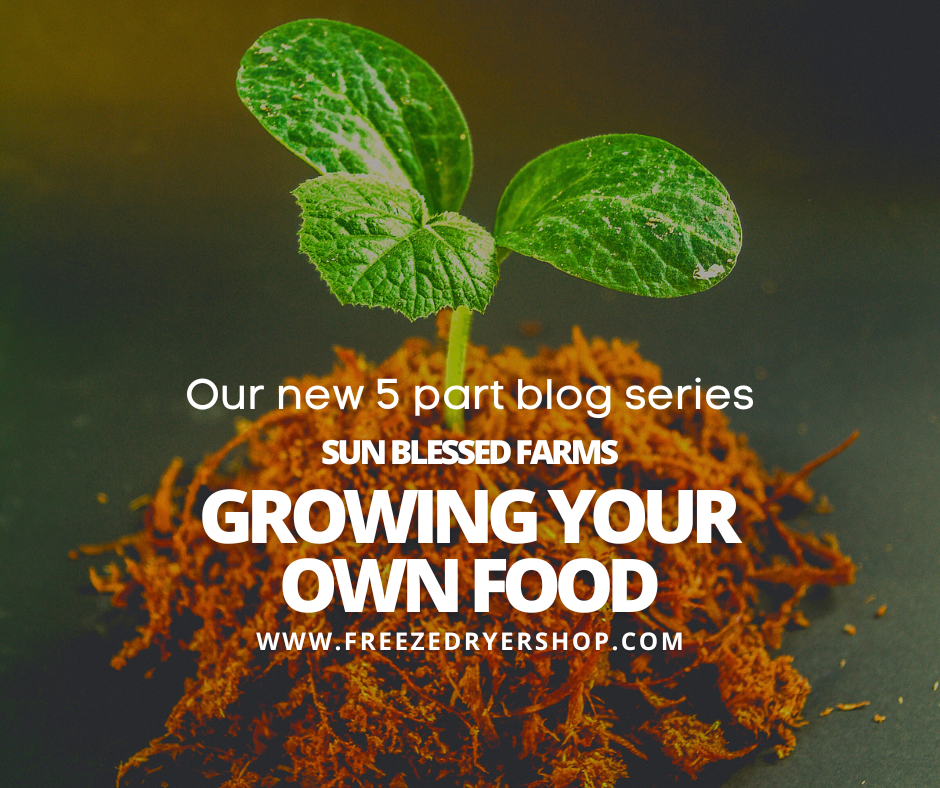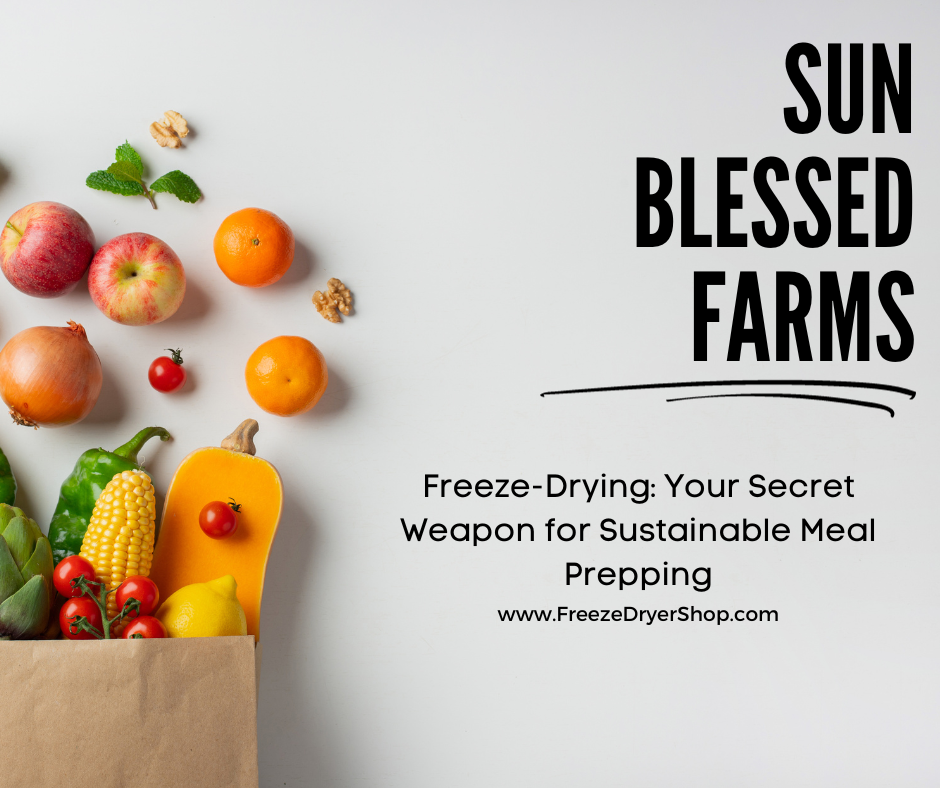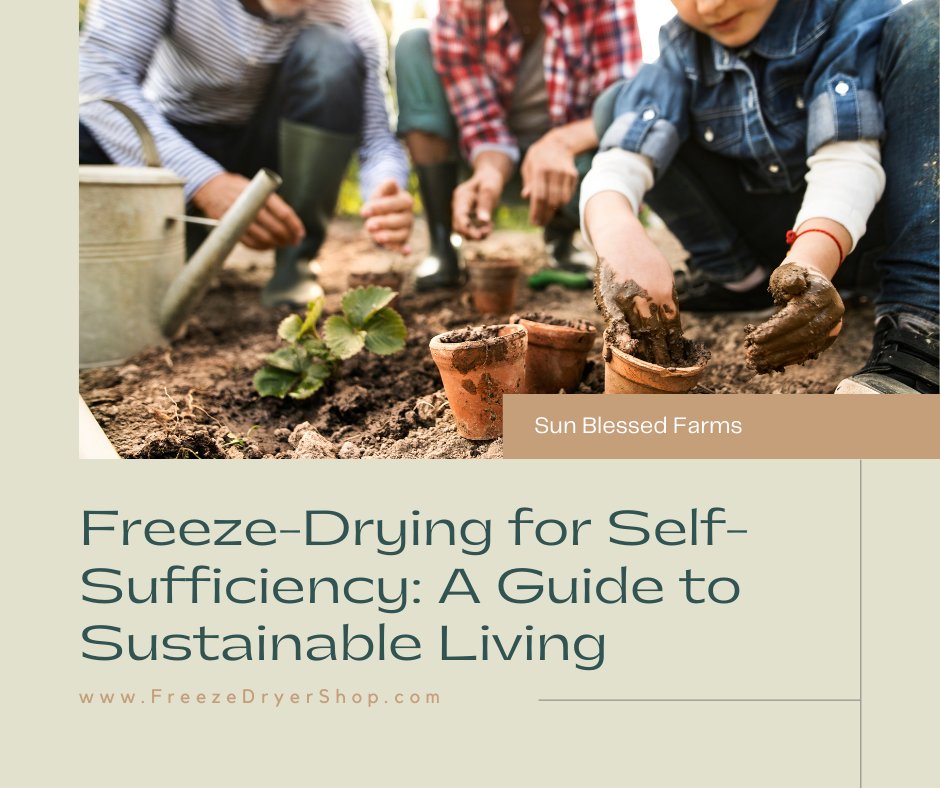Free Shipping to the lower 48 on all freeze dryers!

Please expect up to 4-6 weeks for your order to ship.
Growing Your Own Food Part 4
A Healthy And Thriving Garden:
Introducing the fourth installment of our 'Growing Your Own Food' series, where we dive into the essential aspects of cultivating 'A Healthy And Thriving Garden.' In this part, we will explore the key factors that contribute to the overall well-being of your garden, ensuring it flourishes and provides an abundance of fresh produce. Let's embark on a journey to create a garden that not only sustains itself but also enhances your overall gardening experience.
Here are the key points we'll cover in this insightful blog:
- Soil Health: We'll delve deep into the foundation of any thriving garden—soil. Discover the importance of nutrient-rich soil, the role of compost, and the significance of pH balance for optimal plant growth.
- Pest Management: Learn effective strategies for keeping common garden pests at bay while maintaining a healthy ecosystem in your garden. We'll discuss natural pest control methods and ways to attract beneficial insects.
- Plant Diversity: Explore the advantages of cultivating a diverse range of plants in your garden. We'll discuss companion planting, crop rotation, and how a varied garden can enhance soil health and reduce disease.
- Watering Techniques: Find out how to strike the right balance when it comes to watering your garden. Proper watering is crucial for plant growth, and we'll cover methods to conserve water while ensuring your plants receive the hydration they need.
- Organic Gardening: Embrace the principles of organic gardening, including the use of organic fertilizers and the avoidance of synthetic chemicals. Discover how organic practices can lead to healthier, tastier produce.
- Seasonal Planning: Get a grasp of the importance of planning your garden according to the seasons. We'll discuss how planting and harvesting at the right times can maximize your garden's productivity.
By delving into these key aspects of garden health and maintenance, you'll be well-equipped to nurture a garden that thrives, providing you with a bountiful harvest of homegrown goodness. Join us in this exploration of creating 'A Healthy And Thriving Garden' and elevate your gardening game to new heights.
Soil Health:
The health of your garden's soil is one of the most critical factors in ensuring a bountiful and thriving harvest. Soil provides essential nutrients, water retention, and support for plant roots, making it the foundation upon which your garden depends. In this section of our "Growing Your Own Food" series, we'll delve into the importance of soil health and how you can nurture it to create an ideal growing environment for your plants.
Understanding Soil Health
Before we dive into soil health, it's essential to understand what it means. Healthy soil is not just dirt; it's a living ecosystem teeming with organisms, organic matter, minerals, and microorganisms. These elements work together to provide plants with the necessary nutrients and support they need to grow and thrive.
Testing Your Soil
One of the first steps in promoting soil health is to know what you're working with. Soil testing can provide valuable insights into your soil's composition, pH levels, and nutrient content. You can purchase DIY soil test kits or send samples to a local agricultural extension office for more comprehensive analysis. Understanding your soil's characteristics will help you make informed decisions about amendments and treatments.
Amending Your Soil
Once you have a better grasp of your soil's condition, it's time to consider soil amendments. Common soil amendments include compost, aged manure, peat moss, and organic matter. These materials improve soil structure, water retention, and nutrient content. Incorporating them into your garden beds can enhance soil health over time, making it more conducive to plant growth.
Crop Rotation
Another effective strategy for maintaining soil health is crop rotation. Rotating your crops each season helps prevent soil depletion of specific nutrients and reduces the risk of pest and disease buildup. Different plants have varying nutrient needs, so rotating them can help balance nutrient levels in the soil naturally.
Cover Cropping
Cover cropping involves planting specific crops, such as clover or rye, during the off-season to protect and enrich the soil. Cover crops help prevent erosion, suppress weeds, and add organic matter when they are eventually turned back into the soil. It's an excellent way to keep your garden's soil active and healthy throughout the year.
Soil health is the cornerstone of a thriving garden. By understanding your soil's composition, amending it as needed, practicing crop rotation, and utilizing cover crops, you can create an environment where your plants can flourish.
Pest Management:
In any thriving garden, pest management is a crucial aspect of ensuring the health and productivity of your plants. While it's natural to encounter pests and insects in your garden, understanding how to manage and mitigate their impact is essential. In this section of our "Growing Your Own Food" series, we'll explore pest management strategies to help you maintain a healthy and thriving garden.
Identifying Garden Pests
The first step in pest management is identifying the culprits. Keep a watchful eye on your plants, looking for signs of damage, discoloration, or unusual activity. Common garden pests include aphids, caterpillars, snails, and slugs. By recognizing the specific pests affecting your garden, you can tailor your pest management approach more effectively.
Natural Predators
Nature provides us with allies in the battle against garden pests. Encourage beneficial insects and animals that prey on garden pests, such as ladybugs, lacewings, and birds. Planting nectar-rich flowers can attract these natural predators to your garden. Additionally, creating habitats like birdhouses and insect hotels can provide shelter for these helpful creatures.
Companion Planting
Companion planting is a gardening technique that involves planting certain plants together to benefit one another. Some plants can repel or deter pests when planted alongside others. For example, marigolds are known to deter aphids and nematodes, making them excellent companions for various garden crops. Research companion planting combinations that work well for your specific plants.
Organic Pest Control
Many gardeners prefer to use organic pest control methods to avoid harsh chemicals. Organic options include neem oil, diatomaceous earth, and insecticidal soaps. These treatments target specific pests while minimizing harm to beneficial insects and the environment.
Crop Rotation
Crop rotation not only helps with soil health but also disrupts the life cycles of certain pests. By moving crops to different areas of your garden each season, you can prevent the buildup of soil-borne pests and diseases. Be sure to research suitable crop rotation plans for your region and garden size.
Monitoring and Early Intervention
Regularly inspect your plants for signs of pest infestations, and take action promptly. Hand-picking larger pests like caterpillars or using a strong spray of water to dislodge aphids can be effective. For severe infestations, consider using biological controls like releasing beneficial nematodes or parasitic wasps.
Maintaining a healthy and thriving garden requires proactive pest management. By identifying garden pests, encouraging natural predators, practicing companion planting, using organic pest control methods, implementing crop rotation, and monitoring your plants, you can minimize the impact of pests and enjoy a more productive garden.
Plant Diversity:
In a healthy and thriving garden, plant diversity plays a crucial role in promoting overall well-being. The concept of plant diversity revolves around growing a variety of plant species, rather than just focusing on a single type of crop. In this section of our "Growing Your Own Food" series, we'll explore the importance of plant diversity and how it can significantly impact the health and success of your garden.
Resilience Against Pests and Diseases
One of the primary benefits of planting a diverse range of crops in your garden is that it can help protect against pests and diseases. When you grow a single type of plant in a monoculture, it becomes more susceptible to specific pests and diseases that target that particular species. However, in a diverse garden, pests are less likely to establish a stronghold, as they may not find their preferred host plants in abundance. This reduces the risk of widespread infestations and the need for chemical interventions.
Enhanced Soil Health
Different plants have varying nutrient requirements and root structures. Planting a diverse array of crops helps improve soil health by reducing nutrient depletion and preventing soil erosion. Certain plants, like legumes, are nitrogen-fixers, enriching the soil with this essential nutrient. Others, with deep taproots, can break up compacted soil and improve drainage. The result is a more balanced and fertile garden soil that supports healthy plant growth.
Optimal Use of Garden Space
Planting diverse crops allows you to utilize your garden space more efficiently. Some plants, like climbing beans or vining squashes, can be trained to grow vertically, making use of vertical space and maximizing your garden's potential. Companion planting, where compatible plants are grown together, also optimizes space while enhancing plant health.
Improved Pollination and Beneficial Insects
A diverse garden attracts a broader range of pollinators and beneficial insects. Different flowers and plant species provide nectar and pollen sources throughout the growing season, attracting bees, butterflies, and other pollinators. These insects play a vital role in fertilizing flowers and ensuring the production of fruits and vegetables. Additionally, diverse gardens offer shelter and habitat for beneficial insects that prey on garden pests, contributing to natural pest control.
Culinary Variety
Beyond the garden's health, plant diversity enhances your culinary experiences. Growing a diverse range of fruits, vegetables, herbs, and edible flowers introduces a rich palette of flavors, textures, and aromas to your kitchen. You can explore unique recipes, experiment with diverse ingredients, and enjoy a more varied and nutritious diet.
Plant diversity is a cornerstone of a healthy and thriving garden. By cultivating a wide range of plant species, you not only protect against pests and diseases but also improve soil health, optimize garden space, attract beneficial insects, and expand your culinary horizons.
Watering Techniques:
Effective watering techniques are a vital aspect of maintaining a healthy and thriving garden. In this section of our "Growing Your Own Food" series, we'll explore the importance of proper watering and share techniques to ensure your plants receive the right amount of moisture for optimal growth.
Understanding Your Plants' Needs
Different plants have varying water requirements, so it's essential to understand the specific needs of the crops in your garden. Some vegetables, like tomatoes and cucumbers, prefer consistently moist soil, while others, like herbs or drought-tolerant varieties, can thrive with less frequent watering. Research and observation will help you determine the watering preferences of your garden's occupants.
Watering Depth and Frequency
One key aspect of effective watering is to provide moisture at the right depth. Shallow watering encourages shallow root growth, which can make plants more susceptible to stress during dry periods. To encourage deep and robust root systems, water deeply and less frequently. Aim to moisten the soil to a depth of 6-8 inches for most plants.
Morning Watering
Watering in the morning is generally recommended. It allows the foliage to dry quickly, reducing the risk of fungal diseases that thrive in damp conditions. Additionally, morning watering ensures that plants are hydrated and prepared for the day ahead.
Avoid Overhead Watering
While overhead sprinklers might be convenient, they can also waste water and increase the risk of fungal diseases. Drip irrigation or soaker hoses deliver water directly to the base of plants, minimizing moisture on the foliage. This targeted approach is particularly beneficial for crops like tomatoes, where wet leaves can lead to issues like blight.
Mulching for Moisture Retention
Mulching around your plants is an excellent technique for conserving soil moisture. A layer of organic mulch, such as straw, leaves, or compost, helps to reduce evaporation, maintain soil temperature, and suppress weeds. It also contributes to a healthier soil structure, promoting beneficial microbial activity.
Monitoring and Adjusting
Regularly monitor the moisture level of your garden soil. Stick your finger into the soil to assess its moisture content. If it feels dry a couple of inches below the surface, it's time to water. However, if the soil is still moist, hold off on watering until it dries out slightly. Adjust your watering schedule based on weather conditions and the specific needs of your plants.
Proper watering techniques are essential for a healthy and productive garden. Understanding your plants' water requirements, watering at the right depth and time, avoiding overhead watering, using mulch, and regular monitoring are all key practices to keep your garden hydrated and flourishing.
Organic Gardening:
In the quest for a healthy and thriving garden, embracing organic gardening practices can be a game-changer. Organic gardening focuses on nurturing the soil, plants, and ecosystems in a natural and sustainable manner, minimizing the use of synthetic chemicals and promoting ecological balance.
One of the fundamental principles of organic gardening is building and maintaining healthy soil. Organic gardeners prioritize the use of organic matter, such as compost and mulch, to improve soil structure, enrich it with essential nutrients, and foster beneficial microorganisms. By doing so, they create a thriving environment where plants can flourish naturally.
Organic gardening also promotes biodiversity, encouraging the planting of a variety of crops and flowers to attract pollinators and beneficial insects. This diversity helps in pest management, reducing the need for chemical interventions. Additionally, companion planting, a technique widely used in organic gardening, involves strategically planting different species together to maximize growth and minimize pests.
Another key aspect of organic gardening is the avoidance of synthetic pesticides and herbicides. Instead, organic gardeners opt for natural alternatives like neem oil, diatomaceous earth, or introducing predatory insects to control unwanted pests. This approach not only protects the environment but also ensures that the produce harvested is free from harmful residues.
Furthermore, organic gardening supports sustainable water management. Techniques like mulching and drip irrigation help conserve water, an increasingly precious resource, while promoting healthier root systems and minimizing soil erosion.
In essence, organic gardening aligns with the principles of sustainable and eco-friendly practices, ensuring that your garden not only provides you with bountiful harvests but also contributes positively to the environment. Whether you're a seasoned gardener or just starting, embracing organic gardening can lead to a healthier, more vibrant, and thriving garden that benefits both you and the planet.
Seasonal Planning:
Seasonal Planning: Timing Matters in Your Garden
In the pursuit of a healthy and thriving garden, the importance of seasonal planning cannot be overstated. Every successful gardener knows that timing is a crucial factor in ensuring the best possible results from their efforts. By understanding your local climate and working in harmony with the seasons, you can optimize your garden's productivity and overall health.
Seasonal planning begins with choosing the right crops for each season. Some plants thrive in the warmth of summer, while others are more resilient in cooler weather. Understanding the growing requirements of your selected vegetables, fruits, and herbs is essential for a flourishing garden. This approach also helps you avoid potential issues, such as heat stress or frost damage.
Planting schedules are another vital aspect of seasonal planning. Knowing when to sow seeds or transplant seedlings ensures that your garden remains productive year-round. Many gardeners rely on planting calendars specific to their region, which provide guidance on when to start different crops indoors, transplant them outdoors, and when to expect harvests.
Crop rotation is a key component of seasonal planning as well. By rotating crops from season to season, you reduce the risk of soil depletion and minimize the buildup of pests and diseases. Planning your garden layout to accommodate these rotations can significantly enhance your garden's long-term health.
Lastly, seasonal planning includes taking into account the unique challenges and opportunities each season presents. For example, summer may require more frequent watering, while winter may necessitate frost protection measures. Anticipating these seasonal factors helps you proactively address them, ensuring your garden's continued success.
In conclusion, a healthy and thriving garden is the result of meticulous planning and care, with seasonal considerations playing a pivotal role. By selecting the right crops, adhering to planting schedules, practicing crop rotation, and adapting to seasonal challenges, you can enjoy a bountiful and sustainable garden year after year.
#GardeningTips #SeasonalPlanning #OrganicGardening #HealthyGarden #GardenSuccess #GrowingYourOwnFood
Ready to work with
Sun Blessed Farms LLC?
Let's connect! We’re here to help.
Send us a message and we’ll be in touch.
Or give us a call today at (208) 944-4488
Agency Contact Form
We will get back to you as soon as possible
Please try again later
More Marketing Tips, Tricks & Tools
Sun Blessed Farms Expert Advice



 Rating
Rating
All Rights Reserved | Copywrited by Sun Blessed Farms LLC



